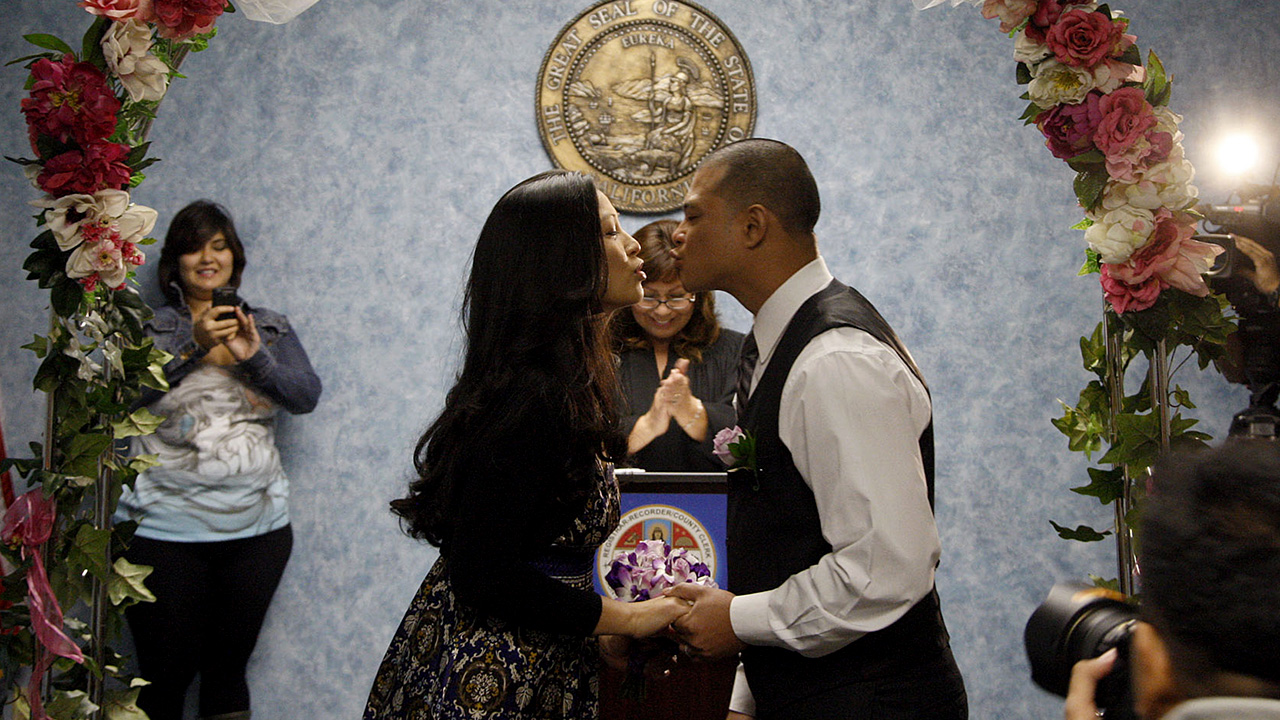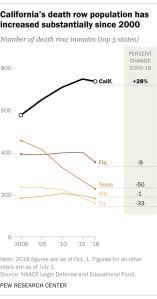
The landscape of relationships in America has shifted dramatically in recent decades. From cohabitation to same-sex marriage to interracial and interethnic marriage, here are eight facts about love and marriage in the United States.
Half of Americans ages 18 and older were married in 2017, a share that has remained relatively stable in recent years but is down 8 percentage points since 1990. One factor driving this change is that Americans are staying single longer. The median age at first marriage had reached its highest point on record: 30 years for men and 28 years for women in 2018, according to the U.S. Census Bureau.
As the U.S. marriage rate has declined, divorce rates have increased among older Americans. In 2015, for every 1,000 married adults ages 50 and older, 10 had divorced – up from five in 1990. Among those ages 65 and older, the divorce rate roughly tripled since 1990.
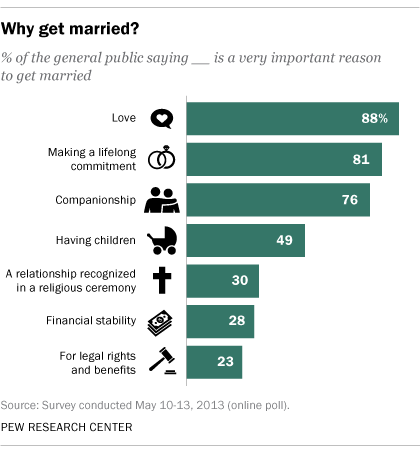
Love tops the list of Americans’ reasons to marry. About nine-in-ten Americans (88%) cited love as a very important reason to get married, ahead of making a lifelong commitment (81%) and companionship (76%), according to a 2013 Pew Research Center survey. Fewer said having their relationship recognized in a religious ceremony (30%), financial stability (28%) or legal rights and benefits (23%) were very important reasons to marry.
However, being a good financial provider was seen as particularly important for men to be a good husband or partner, according to a 2017 survey by the Center. About seven-in-ten adults (71%) said it was very important for a man to be able to support a family financially to be a good husband or partner, while just 32% said the same for a woman to be a good wife or partner.
As far as what helps people stay married, married adults said in a 2015 survey that having shared interests (64%) and a satisfying sexual relationship (61%) were very important to a successful marriage. More than half (56%) also named sharing household chores.
The number of U.S. adults cohabiting with a partner is on the rise. In addition to the half of U.S. adults who were married, 7% were cohabiting in 2016. The number of Americans living with an unmarried partner reached about 18 million in 2016, up 29% since 2007. Roughly half of cohabiters are younger than 35 – but cohabitation is rising most quickly among Americans ages 50 and older.
Large majorities of Generation Zers, Millennials, Generation Xers and Baby Boomers say couples living together without being married doesn’t make a difference for our society, according to a 2019 Pew Research Center report. While 54% of those in the Silent Generation say cohabitation doesn’t make a difference in society, about four-in-ten (41%) say it is a bad thing, compared with much smaller shares among younger generations.
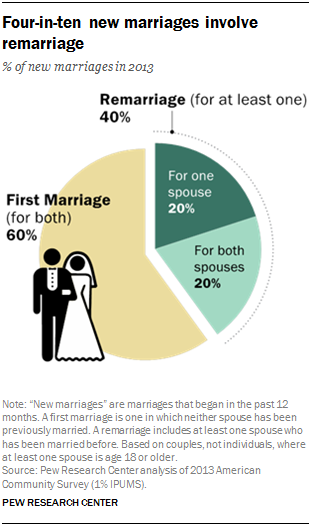
Remarriage is on the rise. In 2013, 23% of married people had been married before, compared with just 13% in 1960. Four-in-ten new marriages in 2013 included a spouse who had said “I do” (at least) once before, and in 20% of new marriages both spouses had been married at least once before.
Remarriage is more common among men than women. Among previously married men (those who were ever divorced or widowed), 64% took a second walk down the aisle, compared with 52% of previously married women, according to a Pew Research Center analysis of 2013 Census Bureau data. One possible reason for this disparity is that women are less interested than men in remarrying. Among previously married women, 54% said in a 2014 Pew Research Center survey that they did not want to marry again, compared with 30% of men.
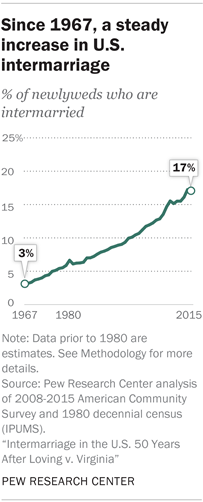
One-in-six newlyweds (17%) were married to someone of a different race or ethnicity in 2015. This reflects a steady increase in intermarriage since 1967, when just 3% of newlyweds were intermarried, according to a 2017 Pew Research Center analysis.
While Asian (29%) and Hispanic (27%) newlyweds are most likely to intermarry in the U.S., the most dramatic increases in intermarriage have occurred among black newlyweds, 18% of whom married someone of a different race or ethnicity, up from 5% in 1980. About one-in-ten white newlyweds (11%) are married to someone of a different race or ethnicity.
Among both Gen Zers and Millennials, 53% say people of different races marrying each other is a good thing for our society, compared with 41% of Gen Xers, 30% of Boomers and 20% of those in the Silent Generation, according to the Center’s 2019 report.
Support for the legalization of same-sex marriage has grown in the past 10 years. In 2007, Americans opposed legalizing same-sex marriage by a margin of 54% to 37%. In 2017, more favored (62%) than opposed (32%) allowing gays and lesbians to marry legally.
Surveys conducted by Gallup found that about one-in-ten LGBT Americans (10%) were married to a same-sex spouse in 2017. Now, a majority (61%) of all same-sex couples who live together are married.
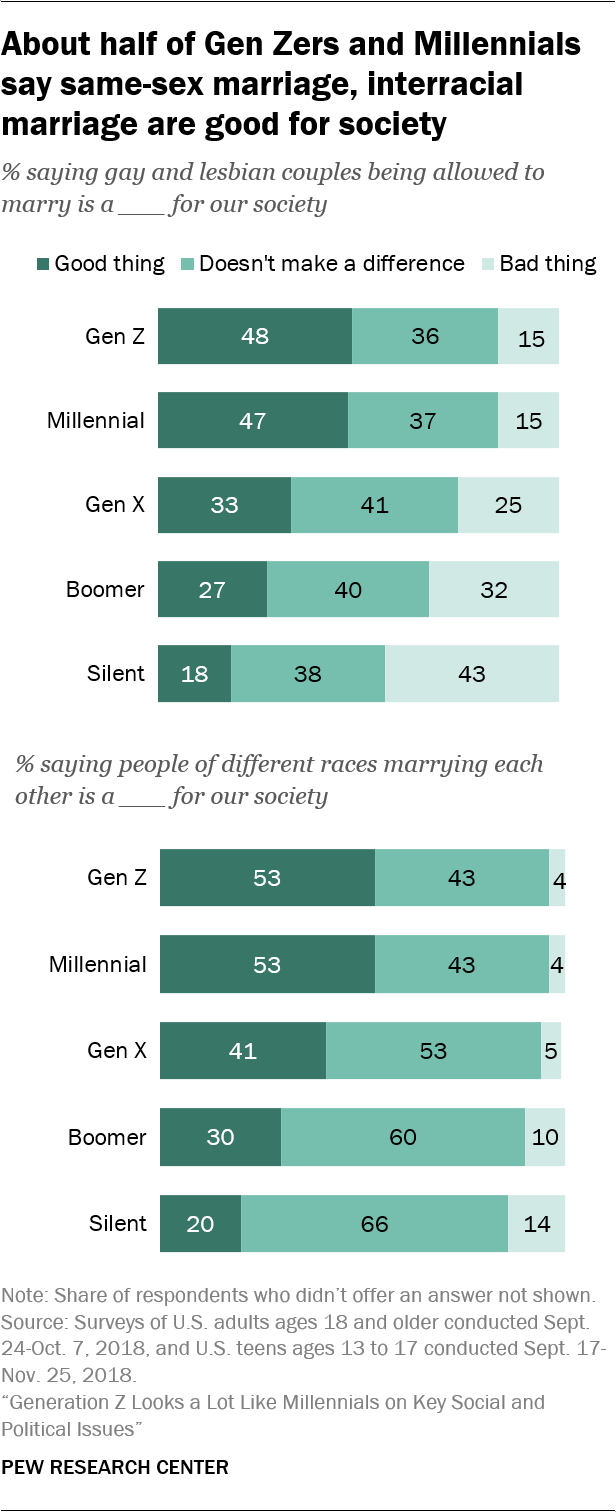
Millennials and Generation Z have been at the vanguard of changing views on same-sex marriage. About half of Gen Zers and Millennials say gay and lesbian couples being allowed to marry is a good thing for our society, while 33% of Gen Xers, 27% of Boomers and 18% of Silents say the same, according to the 2019 report.
Sizable minorities of married people are members of a different religious group than their partner, but marriages and partnerships across political party lines are relatively rare. About four-in-ten Americans who have married since 2010 (39%) have a spouse who is in a different religious group, compared with only 19% of those who wed before 1960, according to a 2014 Pew Research Center survey. Many of these interfaith marriages are between Christians and those who are religiously unaffiliated.
When it comes to politics, a 2016 Pew Research Center survey found 77% of both Republicans and Democrats who were married or living with a partner said their spouse or partner was in the same party.
